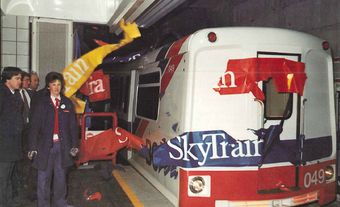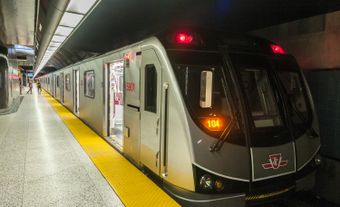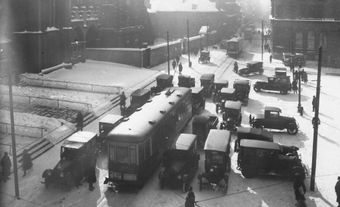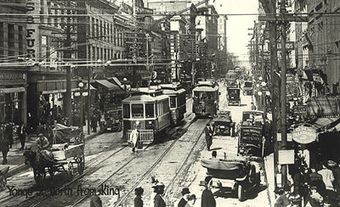CTrain is a light rail transit system in Calgary, Alberta. It is operated by Calgary Transit, a public transit service owned by the City of Calgary and operated through its Transportation Department. Service began on the initial downtown transit corridor and south line in 1981. It expanded to northeast Calgary in 1985, to the University of Calgary in the city’s northwest in 1987 and to the city’s west side in 2012. Most of its route and stations are at surface level. Calgary Transit operates the CTrain in conjunction with an extensive network of bus routes. Through equivalency purchases of wind-generated electricity, it has been entirely wind-powered since 2001. Its two separate lines comprise 45 stations, 118.1 km of track, and an average daily ridership of 312,300 (2018).
History and Early Attempts
Calgary was incorporated as a town in 1884 and as a city in 1894. As early as 1889, municipal authorities considered proposals to franchise a private street railway system. In 1893 the town signed a contract with the Calgary Street Railway Company to build such a network. Within a year, the company abandoned the project, citing poor financial conditions. The City considered the prospect again in 1901 and 1904, but it took no concrete steps while Calgary remained a compact municipality with a small population.
That situation changed by 1906, when a special western census revealed that Calgary’s population had increased nearly 200 per cent, from 4,091 in 1901 to 11,967. Large-scale settlement in western Canada contributed to the city’s dramatic population and real estate boom. A local businessman operated a privately owned transit system in 1905–06 using horse-drawn omnibuses. A second private business, the Calgary Car Company, used motor buses with solid rubber wheels during its three months of operation in 1907. Neither business was successful. In April 1907, on the eve of a massive expansion of Calgary’s municipal boundaries, voters approved construction of a municipally owned street railway system.
The Calgary Electric Railway began service on 5 July 1909, on a short line between downtown and the exhibition grounds (the future Stampede Park), where its car barns were located. Renamed the Calgary Municipal Railway (CMR) by 1910, the system expanded rapidly until 1913, when the city’s pre-First World War boom ended. Routes were identified by colour (such as the Blue Line, the White Line, etc.) until the mid-1930s, when numbers replaced colours to distinguish routes. The final expansion of the streetcar network took place in the 1920s. For its only new route established during the Great Depression, to the upscale Mount Royal neighbourhood, the CMR used buses instead of building a streetcar line. The financial strain of the Depression, followed by the Second World War, prevented significant upgrading or replacement of the CMR.
In 1945, a consulting report recommended conversion from streetcars to rubber-wheeled, electric trolley coaches. Instead, the CMR chose a combination of trolley coaches and gasoline-powered buses, and it made the conversion incrementally between 1946 and 1950. The CMR was renamed the Calgary Transit System (CTS) in 1946; in 1970, the name was simplified to Calgary Transit (CT). In the mid-1970s, CT replaced trolley coaches with diesel-powered buses as a cost-saving measure.
Nearly three decades passed between the system’s abandonment of railed vehicles and the approval of LRT development. Both occurred during the long tenure of R.H. (Bob) Wray as the system’s head between 1949 and 1977. In 1957, Wray toyed with the idea of offering transit service to Calgary’s southern suburbs using railed vehicles on Canadian Pacific Railway tracks. Bill Kuyt, who became Wray’s assistant superintendent in 1961, championed the development of a rail-based rapid transit system and ultimately oversaw its planning and development. Kuyt had emigrated from Europe in 1955 and was familiar with that continent’s electric tramways. His submission of a brief report initiated serious discussions of rail transit. The City commissioned Simpson and Curtin, a Philadelphia planning firm, to study Calgary’s transit system and make recommendations. Their 1966 report recommended a heavy rail system to be built in stages. The system would include an underground or elevated line along a downtown transit corridor with possible links to an overhead walkway system and grade separation outside of the downtown core.
Forging the Concept
The city’s 1968 transportation plan adopted the principle of rail-based transit. This led to land acquisition and right-of-way protection along high priority routes to the city’s south and northwest. In 1972, Calgary Transit inaugurated Blue Arrow, an express bus service along those two future LRT routes. The service also included feeder buses and park-and-ride facilities, which later became elements of the LRT system. Kuyt was among a group of city and CT officials and staff who visited Germany in 1969 to inspect light rail systems, including the Stadtbahn in Frankfurt. That visit contributed to Calgary’s ultimate adoption of the less expensive LRT over the heavy rail alternative. A 1973 report, consistent with the city’s less-than-projected population growth, called for a grade-level LRT system on a more modest scale than the 1967 proposal.
City council endorsed a 1975 report that recommended LRT development on the Macleod Trail corridor. Provincial funding was contingent on an independent review comparing the relative advantages of developing an LRT system, establishing exclusive bus lanes and constructing a busway system with its own right-of-way. On 25 May 1977 — exactly four years before CTrain service began — city council approved the LRT option. Although it had a higher capital cost than the other options, LRT promised significantly lower operating costs than a busway system and, unlike bus lanes, it would not add to congestion on city roads. The electrically powered LRT offered greater energy efficiency than buses, reduced noise and emissions, and had the flexibility to add capacity by increasing frequency of service and the number of cars per train.
Construction of the Original Line
The original line included a 10.9 km route that ran north from Anderson Station to downtown and a 2 km free-fare zone along 7 Avenue in the downtown core. Seventh Avenue was closed permanently to public traffic, and reserved for transit and emergency vehicles. Outside of the downtown core, the CTrain was given traffic signal priority on a protected right-of-way. Seven centre-loading suburban stations and nine downtown curbside platforms were designed by architect Ross E. Hayes and built under a firm budget that maintained public approval. Most suburban stations were designed with a deliberate uniformity, although elements of the two stations that served Stampede Park were designed to suggest the look of a chuckwagon’s covering. The original stations’ interior design was updated in the late 1990s.
The initial complement of light rail vehicles (LRVs) comprised 27 Siemens-Duewag U2 DC cars that were manufactured in Dusseldorf, West Germany, and assembled at the Anderson Road Shop and Yard Complex, a purpose-built CTrain facility that opened in 1979. By 1989, Calgary Transit had acquired a total of 85 West German-made Siemens-Duewag LRVs. The vehicle exteriors were white on delivery; to save paint, CT developed a new colour scheme (magenta, navy blue and turquoise stripes on white) instead of painting the vehicles the existing double blue pattern used on CT buses.
While most of the planning and approval had taken place during the mayoralty of Rod Sykes and construction during that of Ross Alger, the CTrain became widely associated with Mayor Ralph Klein, who had defeated Alger in 1980. Many Calgarians long referred to the LRT as “Little Ralphie’s Train.” During the first run on 25 May 1981, Klein sat at the controls for part of the trip and drove it through a ceremonial paper banner — and through a red light. Four retired streetcar motor-conductors were among the passengers on the first run. “Those streetcars were a damned nuisance,” said one, Percy Langley, to the Calgary Herald. “These are a lot better.”
Development of a Second Line and Expansion of the First Route
In a possible nod to the streetcar system, the original line was briefly styled as the Blue Line. Before long, it was redesignated as Route 201. The next phase of development was meant to be the heavily travelled northwest route to the University of Calgary. Intense public debate over the alignment through the inner-city Sunnyside district led Calgary Transit to postpone the extension and advance construction of a second line, Route 202, along existing rights-of-way in the medians of Memorial Drive and 36th Street NE. The 9.8 km line, with its two downtown curbside platforms and nine suburban stations, opened on 29 April 1985 and extended to Whitehorn Station. The new stations again projected uniformity, although those along Memorial Drive were coloured green to reflect the tree-lined boulevard; the others were burgundy. Design elements at Barlow/Max Bell and Zoo stations, which included concrete murals and animal cutouts, established local character. Unlike those on Route 201, the new stations featured wheelchair accessibility.
In advance of the XV Olympic Winter Games in 1988, Route 201 was extended northwest to the University of Calgary, the site of the Olympic Oval, athletes’ village and McMahon Stadium, the venue for the opening and closing ceremonies. Service on the new 5.8 km line began on 7 September 1987. Unlike earlier stations, those on the northwest line were designed following community consultation and input, which proved a key factor in winning approval from residents of inner-city communities along the new line. The stations’ varied styles, designed by various architects, were intended to fit in with local architecture. Those built in residential areas were designed to a reduced scale, while the interim terminus at University Station incorporated elements of historic railway stations. Banff Trail was the first CTrain station to be built partly below ground level.
A 0.8 km extension to Brentwood Station, the last addition to the network in the 20th century, opened on 31 August 1990. The station had been anticipated as the line’s terminus, but it was delayed over transportation factors and the rush to complete service in time for the Olympics. CT sought a strong design for the new terminus, which architect Robert Leblond designed to resemble a grain elevator.
Expansion
In 2001, Calgary Transit’s “Ride the Wind” initiative established a zero-emission balance by purchasing the equivalent of the CTrain’s electrical consumption in wind-generated electricity. (The electric grid does not distinguish between electricity produced by natural gas, coal or wind. This means that the CTrain is not truly powered by wind-power only, but the purchase of an equivalent amount of wind-power makes it virtually so.) The move helped the city meet its reduction targets for greenhouse gas emissions, and it ultimately proved to be a cost-saving measure. That same year, CT began expanding its existing lines into more distant suburbs. Route 201 was extended south to Fish Creek–Lacombe in 2001 and to Somerset–Bridlewood in 2004, and northwest to Dalhousie in 2003, Crowfoot in 2009 and Tuscany in 2014. Route 202 reached northeast to McKnight–Westwinds in 2007 and Saddletowne in 2012. New stations introduced novel materials such as timber and copper siding, and they included design features like hipped roofs (at Canyon Meadows Station, to blend with adjacent residential neighbourhoods) and the suggestion of opened stage curtains (at Dalhousie Station, to celebrate the daily procession of commuters). In 2001, and again from 2005 and 2012, curbside platforms along 7 Avenue downtown were replaced by structures with a gentle rise that integrated the sidewalks and platforms and linked them to adjacent building faces and storefronts. A ceremonial City Hall station, built in 2011, uniquely features facing platforms on both sides of 7 Avenue and provides a gateway to and from downtown. The new 7 Avenue platforms were also designed to accommodate a change from three-car to four-car trains. Suburban station platforms were similarly rebuilt to accommodate four-car trains, which began service in 2015.
The new stations were also subject to the city’s 2004 public art policy, which mandated that 1 per cent of expenditure on major projects be dedicated to site-specific public art. The station platform at McKnight–Westwinds, for example, was decorated with selected family photographs contributed by area residents and meant to reflect the neighbourhood’s character. At the park-and-ride lot at Tuscany Station, local artist Roman L’Abbee’s mural Flotsam, painted on three sides of the automated public toilet, is a meditation on wind energy, which powers the CTrain.
Did you know?
On 18 February 2009, Calgary Transit recorded its one-billionth rider.
In the first substantial expansion in 25 years, CT began service on the west extension of Route 202 on 10 December 2012. Its six stations, ending at 69 Street Station, include angled and tubular forms. Sunalta is the system’s only elevated station, and Westbrook is its only underground station. The 45 Street and 69 Street stations are trenched.
In 2008, CT began changing the colour scheme of LRVs and buses to a red-and-grey wave on a white vehicle. Beginning in 2001, all new LRVs acquired by CT were manufactured by Siemens in California rather than Germany. In 2013, CT purchased 63 new LRVs to supplement its existing rolling stock and to replace retired vehicles. The new vehicles entered service in 2016–17.
Current Debates and Future Development
The next CTrain line is a 46 km route that will extend from the planned north-centre neighbourhood of Keystone Hills to the south-central Seton subdivision. The Green Line, as it has been styled, will pass through the downtown core, and it will have connections to Stampede Park and Studio Bell (the National Music Centre). Construction is expected to occur between 2020 and 2026, with an estimated cost of $4.9 billion. Bus Rapid Transit (BRT) lines, using articulated express buses, have already been established on projected future CTrain routes. Another current priority is transit-oriented development, which has become evident at such stations as Bridgeland in the northeast, and Brentwood and Sunnyside in the northwest. This concept emphasizes high-density, mixed-use development within a 600 m radius of an LRT station or a BRT stop.
Impact
Calgary’s early adoption of the LRT concept has proven wise. By providing reliable and efficient service to the downtown core as well as suburban areas, the CTrain has facilitated high-density development downtown and relieved pressure to build or expand freeways to accommodate the city’s outward growth. It has contributed to the development of a city form in which transit stations and high-density suburbs support each other. With more than 91 million passenger trips in 2018, the CTrain has one of the highest ridership numbers among light rail systems in North America.

 Share on Facebook
Share on Facebook Share on X
Share on X Share by Email
Share by Email Share on Google Classroom
Share on Google Classroom





































